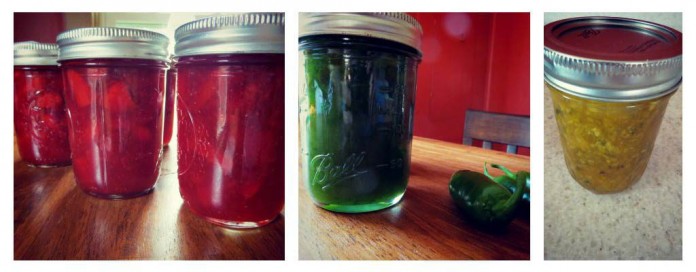My friend makes flawless fruit preserves. Each time she makes a new batch of jam or jelly she brings over a jar to sample. Whether it’s traditional strawberry jam, exotic jalapeno or old-timey elderberry jelly, her fruit preserves are always full of flavor and well set. “What’s your secret?” I asked as I licked perfect peachy preserves off my fingers.
“50 years practice!” she laughed, and shared 5 tips for perfect jam and jelly:
#1. Use the freshest fruit possible.
Pectin naturally occurs in all fruit as structural support. When fruit is fresh it has the highest amount of pectin. As it ripens the amount of pectin in fruit decreases, transforming texture to mush. Preserving fruit when it is fresh makes use of its abundant pectin supply, helping jam and jelly to set and suspend fruit chunks throughout.
Using fresh fruit also gives preserves superior color and flavor.
#2. Add pectin to low-pectin fruit preserves, or create fruit combinations to increase the amount of pectin.
Low-pectin fruits like strawberries and apricots require commercial pectin to set properly. Alternatively, combine low-pectin fruits with fruits naturally high in pectin, such as blackberries or apples. The Ball website offers a free pectin calculator that figures the amount of pectin needed based on fruit and quantity input.
When adding pectin always stay true to the type of pectin and amount required in the recipe.
#3. Ingredients and proportions are important.
Fruit, pectin, acid and sugar are the four ingredients required to make fruit preserves. Each is codependent on another. I’ve already mentioned the importance of fresh fruit and pectin. Acid extracts pectin from fruit during simmering. Sugar pulls water away from pectin, helping jam or jelly set, and also adds sweetness. A good recipe has ingredients and proportions designed to maintain the correct balance of fruit, pectin, acid and sugar. Sure-Jell and Ball websites are a fantastic source of no-fail recipes.
Follow recipe directions closely, especially cook time. That extra minute of simmer might be just what your preserves need for a better set.
#4. Store jam and jelly right: Sealed jars versus freezer jars.
High-acid fruit preserves are safe and easy to can. Traditional canning methods seal jam and jelly in jars. It is okay to reuse jars, but make sure they have been cleaned and sterilized. Experts recommend not reusing lids.
Freezer jam and jelly allow you to skip canning all together. No-cook freezer fruit preserves are fast and easy. Specialty plastic freezer jars are superior for storing freezer preserves. They are designed to lock out moisture and prevent freezer burn.
The downfall of freezer fruit preserves is that when thawed, gel tends to separate from liquid. Stirring is a quick fix, but traditional canning avoids the problem.
#5. Enjoy the fruits of your labor within a year.
Keep home-canned fruit preserves in a dark, cool place. The quality of low-sugar jams and jellies deteriorates faster than full-sugar. Discard the preserves if you notice signs of spoilage.
Store jam and jelly in the fridge at 40°F or lower after opening. Fruit preserves taste best when eaten within 1 month of fridge storage.
4 more posts about food preservation:
- Preserve the harvest: Food dehydration July 3, 2015
- How to safely can food: 4 tips for home food preservation May 19, 2015
- Fermentation, the other preservation Nov. 7, 2014
- Preserving food with boiling water canning and pressure canning Aug. 12, 2014
Meet the next foodie!
Sign up for
Around the Table.
It's a FREE weekly e-newsletter all about food. Sign Up Today!
















